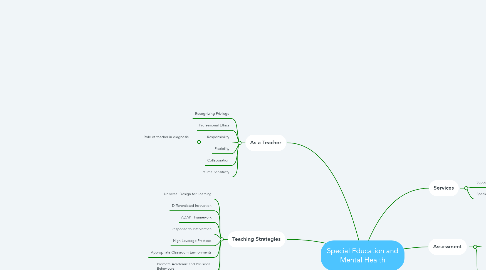Special Education and Mental Health
por Senuri dl


1. As a Teacher
1.1. Recognizing Privilege
1.2. Professional Ethics
1.3. Responsibility
1.3.1. Role of teacher in diagnosis
1.4. Flexibility
1.5. Collaboration
1.6. Trauma Sensitivity
2. Teaching Strategies
2.1. Universal Design for Learning
2.2. Differentiated Instruction
2.3. ADAPT Framework
2.4. Response to Intervention
2.5. High Leverage Practices
2.6. Appropriate Classroom Environments
2.7. Promote Academic and Pro-social Behaviours
2.8. Resource: Pre-referral Intervention Manual (PRIM)
3. Exceptionalities
3.1. Behavioural
3.2. Learning Disorders
3.3. Trauma
3.4. Mental Health
3.5. Second Language Learners
3.5.1. Misdiagnosis of Learning Disorders
3.5.2. Complexities of ELL/FLL learners who also have an exceptionality
3.6. Gifted Students
3.7. Sensory Impairment
3.7.1. Hearing
3.7.2. Vision
3.7.3. Speech
3.8. Resource: DSM-5
4. Services
4.1. Support Staff (ex. EA)
4.2. Special Programming
5. Assessment
5.1. IEP
5.1.1. Educational
5.1.2. Mental/Physical Health
5.1.3. Psychological
5.1.4. Speech/Language
5.1.5. Behavioural
5.2. IPRC
6. Other notes
6.1. A-B-C
6.1.1. Antecedent
6.1.2. Behaviour
6.1.3. Conseguence
6.2. Other factors that affect diagnosis
6.2.1. Race
6.2.2. Gender
6.2.3. Language Learner Status
6.3. Misconceptions and Biases
6.3.1. How does this affect edcation? (ex. sex ed.)
